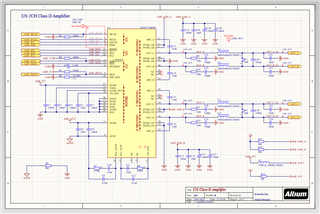Other Parts Discussed in Thread: PCM9211, , PCM5102A, PCM2706
I have a custom PCB with the same schematic of the EVM board.
I'm trying to initialize the chip, I have a workling i2c communication.
But I cannot get any sound from the amplifier.
The i2s signal is generated by the DAC in the PCM9211.
The Main output bus is connected via 33Ohm resisitors to the TAS5731M.
Another DAC (PCM5102a) is connected to another output of the PCM9211 and I have audio.
On a previous thread you sugeste dto get an EVM but it is unobtanium.
I've another product based on the same TAS IC to test out my init init sequence and with that it works.
(See attached init sequence for Logic 2.X below)
I have PVDD set at 12V, AVDD and DVDD are 3.3V.
On bootrap caps I have around 12V. Outputs A,B,C,D are at 6V
ON VREG: 3.1V
On VR_DIG I have: 1.8V
On GVDD_OUT: 7.0V
On SSTIMER: 3.1V
This is the post init register dump of the TAS:
I: Device on address 0x001B I: Device initialized on address 0x001B: 1 V: Going to enable PCM9211 I: Device found on address 0x0040 I: Device initialized on address 0x0040: 1 V: Going to configure PCM9211 I: Main Mux: 2 I: Aux Mux: 2 I: DIT Mux: 4 I: ---TAS5731M------------- I: Reg 0x0000: 0b1101100(0x006C) I: Reg 0x0001: 0b0(0x0000) I: Reg 0x0002: 0b0(0x0000) I: Reg 0x0003: 0b10100000(0x00A0) I: Reg 0x0004: 0b101(0x0005) I: Reg 0x0005: 0b1010(0x000A) I: Reg 0x0006: 0b0(0x0000) I: Reg 0x0007: 0b1001000(0x0048) I: Reg 0x0008: 0b110000(0x0030) I: Reg 0x0009: 0b110000(0x0030) I: Reg 0x000A: 0b110000(0x0030) I: Reg 0x000E: 0b11010001(0x00D1) I: Reg 0x0010: 0b111(0x0007) I: Reg 0x0011: 0b10111000(0x00B8) I: Reg 0x0012: 0b1100000(0x0060) I: Reg 0x0013: 0b10100000(0x00A0) I: Reg 0x0014: 0b1001000(0x0048) I: Reg 0x0019: 0b110000(0x0030) I: Reg 0x001A: 0b1111(0x00F) I: Reg 0x001B: 0b11000000(0x00C0) I: Reg 0x001C: 0b10(0x0002) I: Reg 0x0020: 0b01000100111101111110010(0x0000897772) I: Reg 0x0021: 0b00100000011(0x00000403) I: Reg 0x0025: 0b110100111000101(0x000121345) I: ------------------------
This is the register dump with sound playing (as you can see no error on register 0x02):
I: ---TAS5731M------------- I: Reg 0x0000: 0b1101100(0x006C) I: Reg 0x0001: 0b0(0x0000) I: Reg 0x0002: 0b0(0x0000) I: Reg 0x0003: 0b10100000(0x00A0) I: Reg 0x0004: 0b101(0x0005) I: Reg 0x0005: 0b1010(0x000A) I: Reg 0x0006: 0b0(0x0000) I: Reg 0x0007: 0b1001000(0x0048) I: Reg 0x0008: 0b110000(0x0030) I: Reg 0x0009: 0b110000(0x0030) I: Reg 0x000A: 0b110000(0x0030) I: Reg 0x000E: 0b11010001(0x00D1) I: Reg 0x0010: 0b111(0x0007) I: Reg 0x0011: 0b10111000(0x00B8) I: Reg 0x0012: 0b1100000(0x0060) I: Reg 0x0013: 0b10100000(0x00A0) I: Reg 0x0014: 0b1001000(0x0048) I: Reg 0x0019: 0b110000(0x0030) I: Reg 0x001A: 0b1111(0x00F) I: Reg 0x001B: 0b11000000(0x00C0) I: Reg 0x001C: 0b10(0x0002) I: Reg 0x0020: 0b01000100111101111110010(0x0000897772) I: Reg 0x0021: 0b00100000011(0x00000403) I: Reg 0x0025: 0b110100111000101(0x000121345) I: ------------------------
With the alternative HW if I disconnect power without doing the shutdown procedure I get a bump of the speakers.
With my current design I don't. The speakers are completly muted.
The PCB and schematic is the same of my previous post.

Session TAS.zip
How I can throubleshoot this?






















